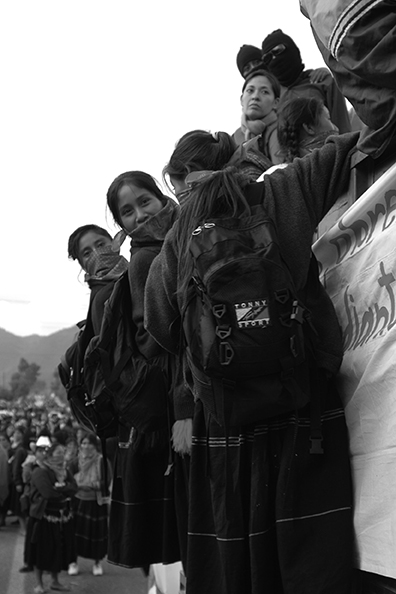
| 1492 | Christopher Columbus arrives in the Americas; |
| indigenous communities often refer to this date as | |
| the beginning of five hundred years of resistance. | |
| 1519-1521 | Spanish conquest of the Aztec Empire, a significant |
| event in the Spanish colonization of the Americas. | |
| 1528 | The conquest of most of Chiapas is completed |
| under the leadership of Spanish conquistador | |
| Diego de Mazariegos. | |
| 1712 | Tzeltal Revolt in the municipality of Cancuc in the |
| highlands of Chiapas. | |
| 1810-1821 | Mexican War of Independence from Spain. |
| 1824 | Chiapas becomes part of Mexico. |
| Mid-1800s | La Reforma, a period of modernizing liberal |
| reforms in Mexico that strip both the church and | |
| indigenous communities of lands; in seeking to | |
| curtail the power of the clergy, La Reforma resulted | |
| in the enrichment of large landholders and wors- | |
| ened conditions for landless peasants. | |
| 1869 | Caste War in the Tzotzil municipality of Cham- |
| ula, sparked by the dispossession of indigenous | |
| communities. | |
| 1910-1920 | Mexican Revolution. |
| 1917 | Mexican Constitution is ratified. |
| 1929 | Formation of the ruling Partido Nacional Revolu- |
| cionario (National Revolutionary Party, PNR), later | |
| renamed the Institutional Revolutionary Party or PRI. | |
| 1930s | Colonization of the Lacandon Jungle by indigenous |
| peasants fleeing from fincas begins. | |
| 1934-1940 | Lázaro Cárdenas is president of Mexico and |
| implements land reform that was promised in the | |
| Mexican Constitution of 1917. | |
| 1950s | Colonization of the Lacandon Jungle intensifies; |
| the government seeks to relieve mounting tensions | |
| over land by encouraging land-poor indigenous | |
| peasants from the highlands to settle the rainforest | |
| in eastern Chiapas. | |
| 1960 | Samuel Ruiz becomes the bishop of the Catholic |
| Diocese of San Cristóbal de las Casas (and would | |
| remain so until the year 2000). | |
| 1969 | Formation of the clandestine National Liberation |
| Forces or FLN in Monterrey, Nuevo Leon. | |
| 1974 | The Indigenous Congress, organized by the Diocese |
| of San Cristóbal, brings together over a thousand | |
| indigenous delegates and catalyzes an increased | |
| level of organization in the indigenous communi- | |
| ties of Chiapas. | |
| Late 1970s | The FLN begins recruiting indigenous members in |
| the northern zone and central highlands of Chiapas. | |
| 1982 | Mexico declares that it is unable to pay its interna- |
| tional loans, triggering a debt crisis and ushering in | |
| an era of strict neoliberal policies. | |
| Nov. 17, 1983 | Members of the FLN form the EZLN. |
| 1992 | Leading up to the implementation of NAFTA, the |
| Mexican Constitution is changed to allow ejidos to | |
| be bought and sold. | |
| 1992 | Alcohol is banned in Zapatista communities. |
| 1993 | The CCRI is formed as the highest body of leader- |
| ship within the EZLN, replacing the nonindigenous | |
| leadership of the FLN. Additionally, the EZLN | |
| passes a series of revolutionary laws, including the | |
| Women’s Revolutionary Law. | |
| Jan. 1994 | Zapatista uprising. |
| Dec. 1994 | The EZLN declares the existence of more than thirty |
| autonomous municipalities. | |
| Feb. 9, 1995 | The Mexican military launches an offensive against |
| Zapatista communities. | |
| Feb. 16, 1996 | The EZLN and the Mexican government sign the |
| San Andrés Peace Accords on Indigenous Rights | |
| and Culture. | |
| July 27- | The EZLN holds the First Intercontinental Gather- |
| Aug. 3, 1996 | ing for Humanity and against Neoliberalism. |
| Oct. 1996 | Comandanta Ramona travels to Mexico City for |
| the founding meeting of the National Indigenous | |
| Congress. | |
| Sept. 1997 | Mobilization of 1,111 Zapatistas to Mexico City. |
| Dec. 22, 1997 | Acteal massacre. |
| 1998 | Series of incursions by the Mexican armed forces |
| into Zapatista villages. | |
| 1999 | The EZLN holds the Consulta Nacional. |
| 2000 | The PRI loses the presidential elections in Mexico |
| after seven decades of one-party rule. | |
| 2001 | The EZLN organizes the March for Indigenous |
| Dignity, and Comandanta Ester becomes the | |
| first indigenous woman to address the Mexican | |
| Congress. | |
| 2005 | The EZLN launches the Other Campaign. |
| 2006 | Comandanta Ramona passes away. |
| 2007 | The Third Gathering between the Zapatista People |
| and Peoples of the World “Comandanta Ramona | |
| and the Zapatistas.” |

Zapatista march in San Cristóbal de las Cases to launch the Other Campaign, January 2006. (Photograph by Francesc Parés.)